DOI:10.32604/iasc.2022.023692

| Intelligent Automation & Soft Computing DOI:10.32604/iasc.2022.023692 |  |
| Article |
Improved Energy Based Multi-Sensor Object Detection in Wireless Sensor Networks
1Department of Computer Science and Engineering, Nandha Engineering College, Erode, Tamil Nadu, India
2Department of Information Systems, Faculty of Computing and Information Technology, King Abdulaziz University, Jeddah, Saudi Arabia
3Department of Information Systems, College of Computer Science and Information Technology, King Faisal University, Saudi Arabia
4Department of Computer Science and Engineering, Swami Keshvanand Institute of Technology, Management & Gramothan, Jaipur, Rajasthan, India
5Department of Computer Science and Engineering, PSN College of Engineering and Technology, Tirunelveli, Tamil Nadu, India
*Corresponding Author: Thirumoorthy Palanisamy. Email: thiru4u@gmail.com
Received: 17 September 2021; Accepted: 21 October 2021
Abstract: Wireless Sensor Networks (WSNs) are spatially distributed to independent sensor networks that can sense physical characteristics such as temperature, sound, pressure, energy, and so on. WSNs have secure link to physical environment and robustness. Data Aggregation (DA) plays a key role in WSN, and it helps to minimize the Energy Consumption (EC). In order to have trustworthy DA with a rate of high aggregation for WSNs, the existing research works have focused on Data Routing for In-Network Aggregation (DRINA). Yet, there is no accomplishment of an effective balance between overhead and routing. But EC required during DA remained unsolved. The detection of objects belonging to the same event into specific regions by the Bayes Node is distributed through the Sensor Nodes (SNs). Multi-Sensor Data Synchronization Scheduling (MSDSS) framework is proposed for efficient DA at the sink in a heterogeneous sensor network. Secure and Energy-Efficient based In-Network Aggregation Sensor Data Routing (SEE-INASDR) is developed based on the Dynamic Routing (DR) structure with reliable data transmission in WSNs. Theoretical analysis and experimental results showed that in WSN, the proposed Bayes Node Energy Polynomial Distribution (BNEPD) technique reduced Energy Drain Rate (EDR) by 39% and reduced 33% of Communication Overhead (CO) using poly distribution algorithm. Similarly, the proposed MSDSS framework increased the Network Lifetime (NL) by 15%. This framework also increased 10.5% of Data Aggregation Routing (DAR). Finally, the SEE-INASDR framework significantly reduced EC by 51% using a Secure and Energy-Efficient Routing Protocol (SEERP).
Keywords: Wireless sensor network; energy efficiency; data aggregation; secure routing protocol
A vast quantity of SNs is contained in WSNs. A sensor is a small method with micro-sensor tools, low power signal processing, low EC, and short-range communication ability. The SNs sense the environment and process the data for communicating it through wireless telecommunication. WSNs have SNs powered by batteries with inadequate energy. WSNs belong to the class of wireless ad hoc networks where SNs gather, process, and communicate data that were attained from the physical environment to Base Station (BS) [1].
WSNs are used in many applications like military and civilian operations for observing the environment. The key objective of a SN is to sense and gather data from a certain domain and transmit them to the sink where the application lies. The interaction between a sensor and the sink forces nodes to send out the messages with high power when resources are reduced. The interaction of nodes with the sink node is required. The data are gathered from the world using WSNs [2]. The aggregated values of all the data are acquired by DA, which is classified by data gathering. The process of accumulating all the data from the network that is void of DA is known as data collection. In the computationally resource-limited WSNs, the Secure Data Aggregation (SDA) in power consumption with positive function is very effective. Minimum computational difficulty, prolonged lifetime, and less latency for data transmission from SNs to sink result from Secure Data Aggregation (SDA) for WSNs. The amount of information that navigates the network is supposed to be reduced for increasing the presence of sensors. The DA is planned to observe the features of SDA. DA mechanisms are designed to minimize the EC. DA contains security threats; however, many DA protocols are secured and enhance resource utilization [3].
Multi-sensor data information collection method on WSN presents sensed data interaction via persistent data gathering with increased delay and energy utilization. In addition, multi-sensor data event detection increases node EDR and leads to ambiguity in DA at the sink. Trustworthy DA with maximum DA rate is caused by DRINA for WSNs though there is no stability between overhead and routing. DRINA approach does not locate equilibrium between data CO and routing efficiency of WSN. The aim of more data collection is achieved by using an algorithm derived from zone pipeline scheduling by Cell-Based Path Scheduling. However, communication between the sensed data occurs through persistent data gathering and delay and energy utilization. Efficient synchronization of data packet scheduling with the SN is a significant element of multi-sensor data event detection. However, particular works aim at multi-sensor DA, but data synchronization is also an important element. DA is the main task in WSN as it helps in minimizing the EC. Data specific routing scheme designed a WSN based Urban Traffic Information Collection for an effective traffic monitoring system to enhance throughput. Recoverable and Concealed DA in WSN derived from the property of recoverable minimized the transmission overhead on both homogeneous and heterogeneous WSNs. However, it has only less NL [4].
WSN nodes construct a multi-hop tree in the network with the sink node that performs as a gateway in the sensing field. All the SNs in the WSN are resource-limited and energy-constrained. In-Network Aggregation (INA) in WSN is a significant method to minimize the transmission overhead as it increases the NL. Energy limitation is the primary concern of numerous WSN applications. INA aims to remove redundant data transmissions by aggregation function and unnecessary data sensing. It also reduces the energy used in communication from application node to sink node. In-network DA helps in minimizing the packet transmission delay in the hop tree or cluster. However, the transmission efficiency is not increased [5].
Muhammad et al. [6] designed a constrained relay node placement in WSNs with formulation and approximations. Constrained descriptions of the relay node issues are studied where relay nodes are positioned at a set of candidate locations. In connected relay node placement issue, a smaller number of relay nodes is used to guarantee the SNs with BS in a bidirectional path. In existing relay node placement complexity, a smaller number of relay nodes assure each SN with two BSs by two node-disjoint bidirectional paths. For each issue, the computation is complex, and therefore, it is necessary to plan a framework of polynomial-time O(1)-approximation algorithms with small approximation ratios.
Hammoudeh et al. [7] subscribed to a lightweight routing approach for INA in WSNs. The WSNs have sense, computation, and communications capabilities. Energy conservation is a main problem in WSN. The Intermediate Nodes (IM) are joined to decrease the number of replaced messages called redundant data. It also minimizes the communication cost and EC and maximizes the lifetime. A new Data Routing for INA algorithm is designed to create a routing tree and high aggregation rate. To discover the shortest path for routing rather than hop count, distance parameter is used to minimize the EC, End-to-End Delay, communication cost, and enhance the NL.
Soderlund et al. [8] recommended a Distributed Multi-Channel MAC Protocol for Ad hoc Wireless Networks. Rapid and slow hopping sequences design a new distributed multi-channel Medium Access Control (MAC) protocol using two radio interfaces. An interface tracks the fast hopping for transmission and slow hopping for reception. The designed protocol is sequenced with the tactics of IEEE 802.11-MAC derived from many approaches. The performance of network and determination of bottlenecks are enhanced using this strategy. The computation of the network performance with the aggregate throughput is performed using an analytical model explicitly designed. The estimation of the higher saturation and achievable throughput is done additionally.
With a Query-Centric Framework of Collaborative Heterogeneous Sensor Networks, where the queries are processed efficiently by making the WSNs work with each other, Shamshirband et al. [9] examined COSE. In COSE, an optimization issue called EE-QPS associated with the discovery of an optimal strategy of handling queries arises regarding energy saving. There is a verification of the NP-hardness of EE-QPS and planning of a heuristic approach called IAP by means of the correlation termed as implication between many sensor networks. In COSE, IAP attains optimized energy efficiency in different settings.
Mobile sink utilization and clustering on energy saving in WSNs are probed into by Haseeb et al. [10]. In mobile WSNs, the mobile elements are sinks or sensors. In WSN, the energy limitation is essential by one. Clustering saves a large quantity of energy in WSNs due to the enhanced methods for DA and transmissions. It also improves the network performance. Energy-aware CLUSTERING algorithms conserve a large amount of energy and have longer NL. Low-Energy Adaptive Clustering Hierarchy (LEACH) clustering algorithm is used in mobile WSNs where the sink can move. With the objective of locating the optimal path connecting cluster heads for the mobile sink, an optimization algorithm derived from ant colonies is employed. The resource and power in cooperative femtocell networks are allocated by design introduced in Markov model. Rami Langar et al. (2015) ushered an approach on operations research game. In order to develop network coverage and capacity in indoor atmosphere, femtocells have gained much popularity to be the key methods. The intervention of Femto-to-Femto is a major problem when several frequency cells are employed by femtocells rather than macrocells. There is a demand for increased available resources by the femtocell, and their improvement is questionable in a congestion case. Like operations research games, the resource and power allocation problems are addressed in which, through practical components, attributions are comprehended from cooperative game theory known as Shapley value and the Nucleolus. The values are accepted by the initial rescaling of user’s demands deliberately. In this way, the rescaled demands’ energy level and Network Throughput (NT) optimization is performed.
Based on similarity matching, Gong et al. [11] wrapped up SDA in Wireless Multimedia Sensor Networks (MWSNs). The issue of SDA in MWSN has large interest in WSN. MWSNs have issues that occur in WSNs with the existence of restricted resources such as sensors’ memory, energy-saving, and functioning of the Central Processing Unit (CPU). The DAs fail to consider the redundancy of the multimedia data. A similarity model and power model are designed to increase the energy efficiency.
The designed scheme partitioned the multimedia data into many pieces and sent out the efficient pieces to the chosen SNs. The designed system uses EC and data transmission to perform significantly better than traditional methods under the resource-limited MWSNs. Energy-Efficient Ant Colony algorithms were introduced for DA in WSNs by Mathur et al. [12]. For DA, an ant colony algorithm called DAACA is designed. Initialization, transmission of packets, and processing of pheromones are the III-phases of DAACA. The chances for choosing the next node are computed by calculating the energy and the number of neighbour nodes’ pheromones by each node in the transmission phase. The changes in the pheromones are carried out after transmissions with both global and local merits for evaporating or depositing pheromones. The four different pheromones’ alteration steps comprise of DAACA family that increases the NL.
3.1 Bayes Node Energy Polynomial Distribution (BNEPD) in Wireless Sensor Network
Initially, the routing problem is solved, and the EDR is minimized by applying the BNEPD technique that is designed with energy-aware routing in WSN [13]. The BNED distributes the SNs that do object detection of similar events in particular areas. Bayes Distribution (BD) is required on the SN organization that consumes less energy for routing the SNs. The SNs that identify the number of target objects are transmitted to the sink through the energy-efficient routing path provided through BD with minimum EC. The Polynomial Regression Function (PRF) is a source of supply for DA at the sink to minimize the EDR of node energy, and in the routing path, it preserves high-energy nodes. Depending on the observation, a new distribution algorithm is designed, and performance analysis is provided by minimizing the CO in Fig. 1.
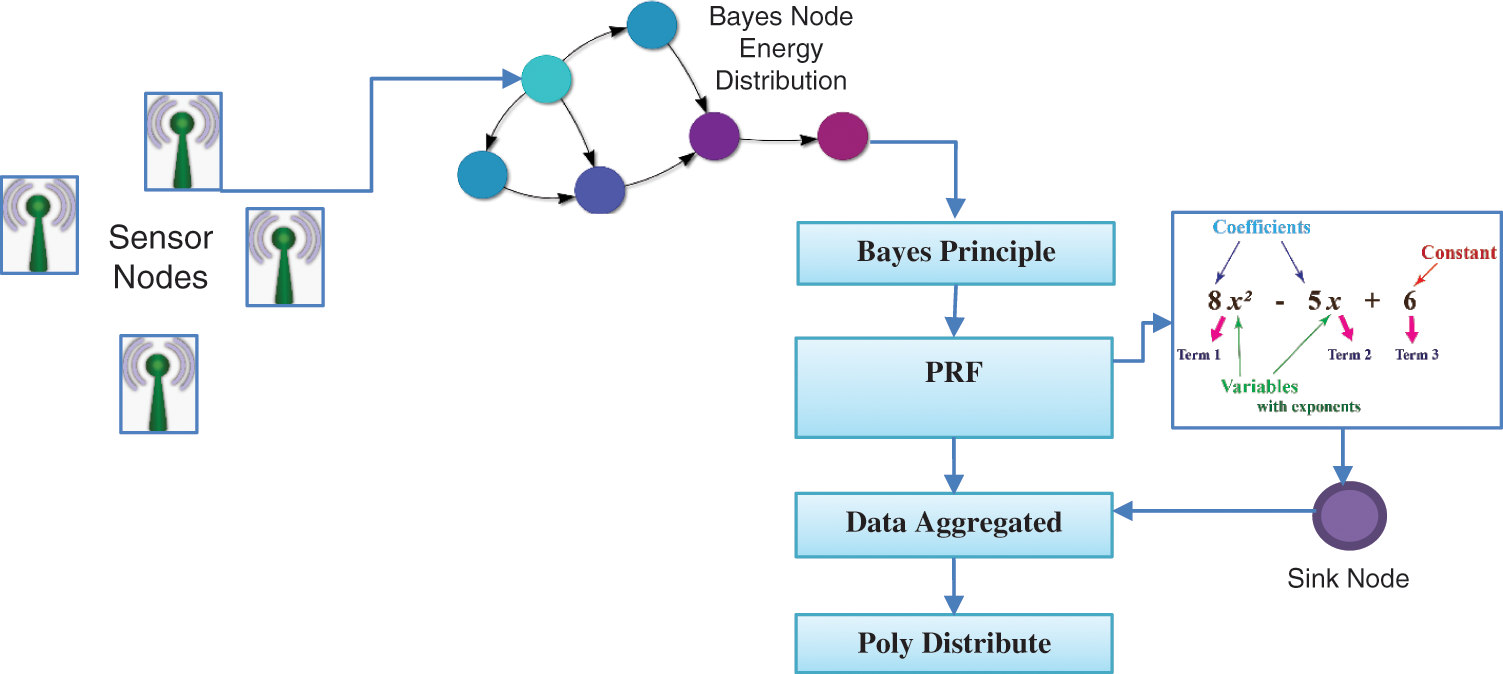
Figure 1: Framework of Bayes node energy polynomial distribution for WSN
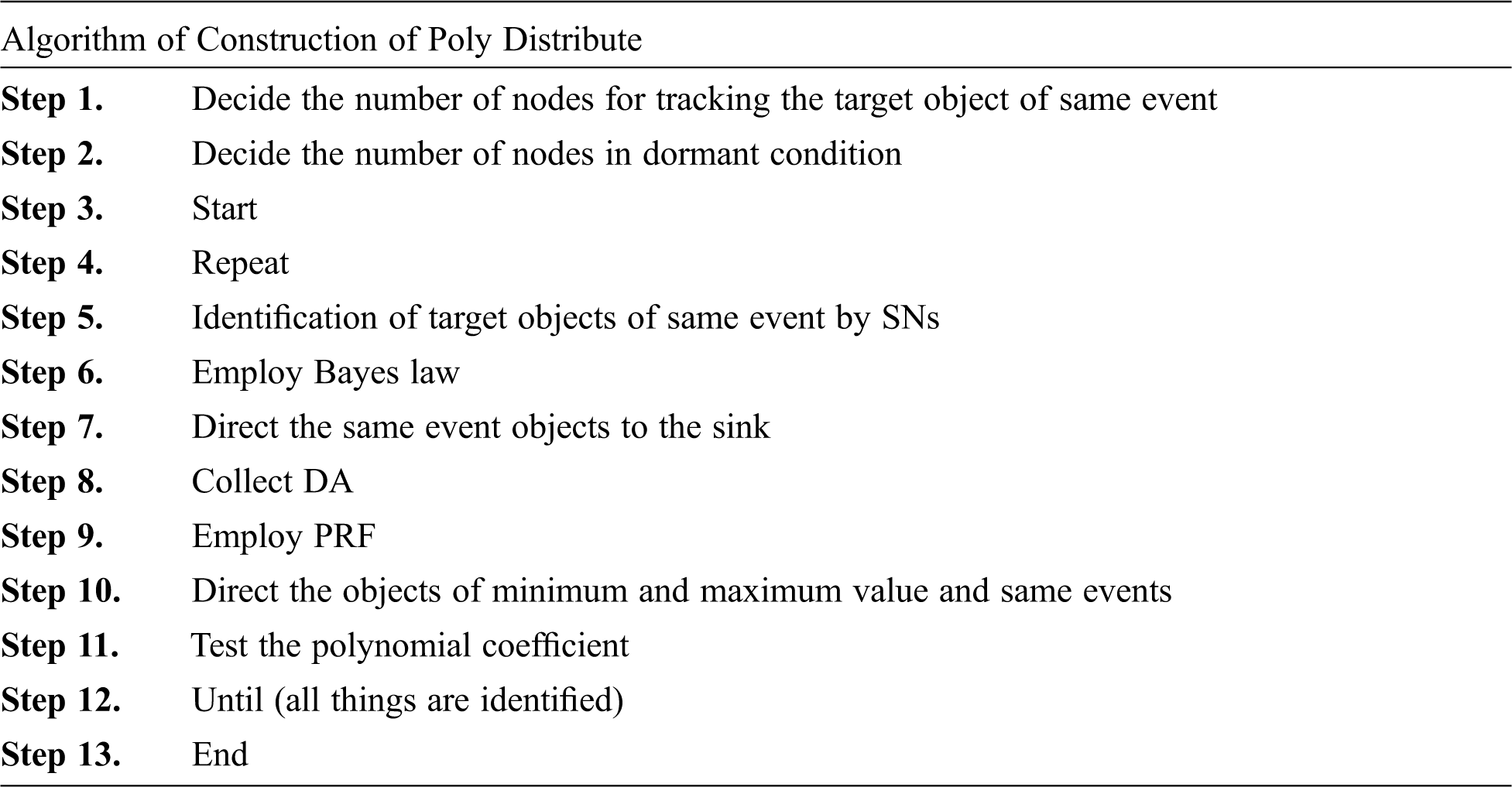
The architecture of poly distribute algorithm is described by the Algorithm that functions in three significant steps. The selection of nodes is the first step in poly distribute algorithm. Randomly, the number of nodes in dormant conditions and the target object of the same event by the SNs are determined. Depending on the residual energy of each SN, the number of nodes in the network is designed randomly based on their presence in the network. On the basis of the probability of events and distance function to the sink node, the second step involves the identification of target object of same events by the SNs. Ultimately, through polynomial coefficient, the minimum and maximum value objects of same events are determined by the performance of DA with the help of PRF. For all the objects in the network, there was a repetition of the process as mentioned above. It minimizes the CO in this manner [14].
3.2 An Efficient Data Aggregation Using Synchronization Scheduling in Wireless Sensor Network
Next, an efficient MSDSS framework is presented to create the WSN network capable of controlling heterogeneous SNs for efficient DA at the sink. MSDSS allows the SNs to plan the identified sensed data for transmission to equivalent sink with many event detectors. The MSDSS framework employs Work Flow-based Data Synchronization for reducing the EC. Synchronization of the data scheduling to the equivalent SN is created through mapping of identified event to time pulse. It is also dynamically stored in vector quantization. The MSDSS framework for synchronization uses the Decision Rule-based Vector Quantizer model by enhancing the resources used and increasing the NL. Lastly, the Synchronization Thread for Vector Quantizer model divides the threads created for Multi-Sensor Events (M-SE), resulting in the improved multi-sensed DAR [15]. An intensive study shows the efficiency of these enhancements with better performance in terms of EC; it enhances the resource utilization, NL, and multi-sensed DA. A rich set of workflow-based data synchronization is coupled with the distributed detection from multi-sensor for efficient DA at the sink node in WSN. Fig. 2 shows the architecture diagram of MSDSS framework that includes workflow-based data synchronization, distributed detection from multi-sensor and vector quantizers.

Figure 2: The proposed architecture of MSDSS

Figure 3: In-network aggregation tree structure
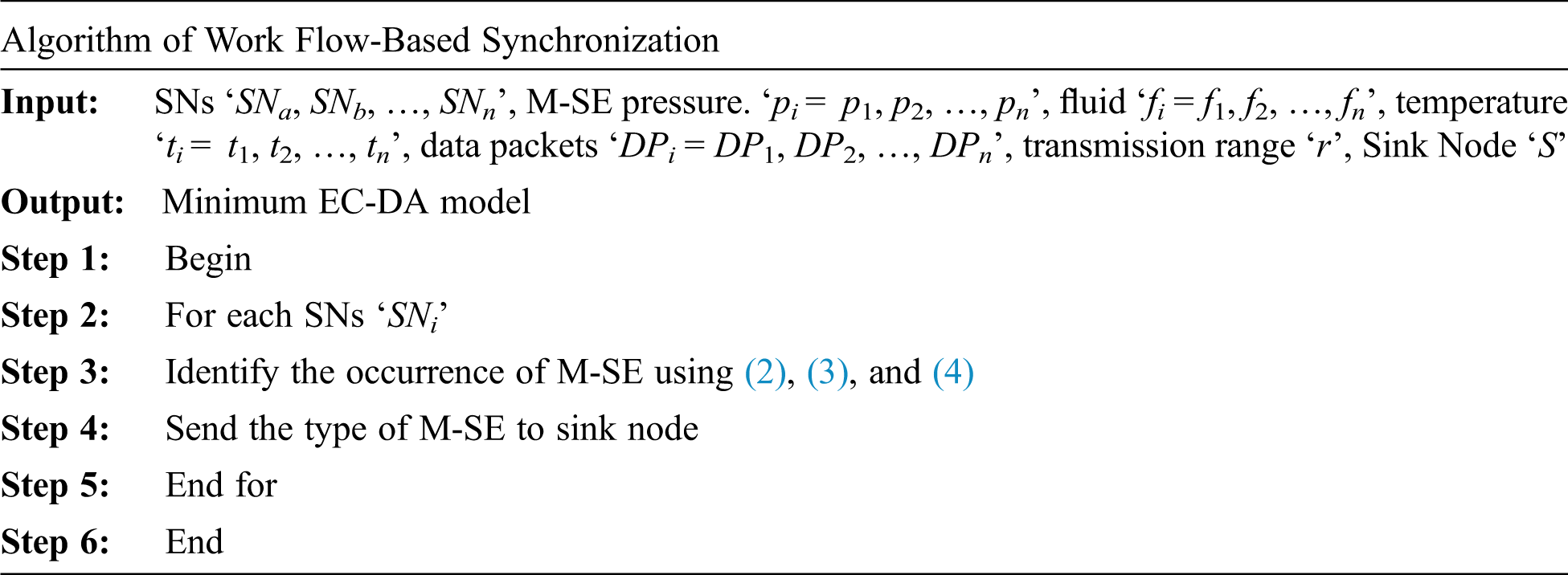
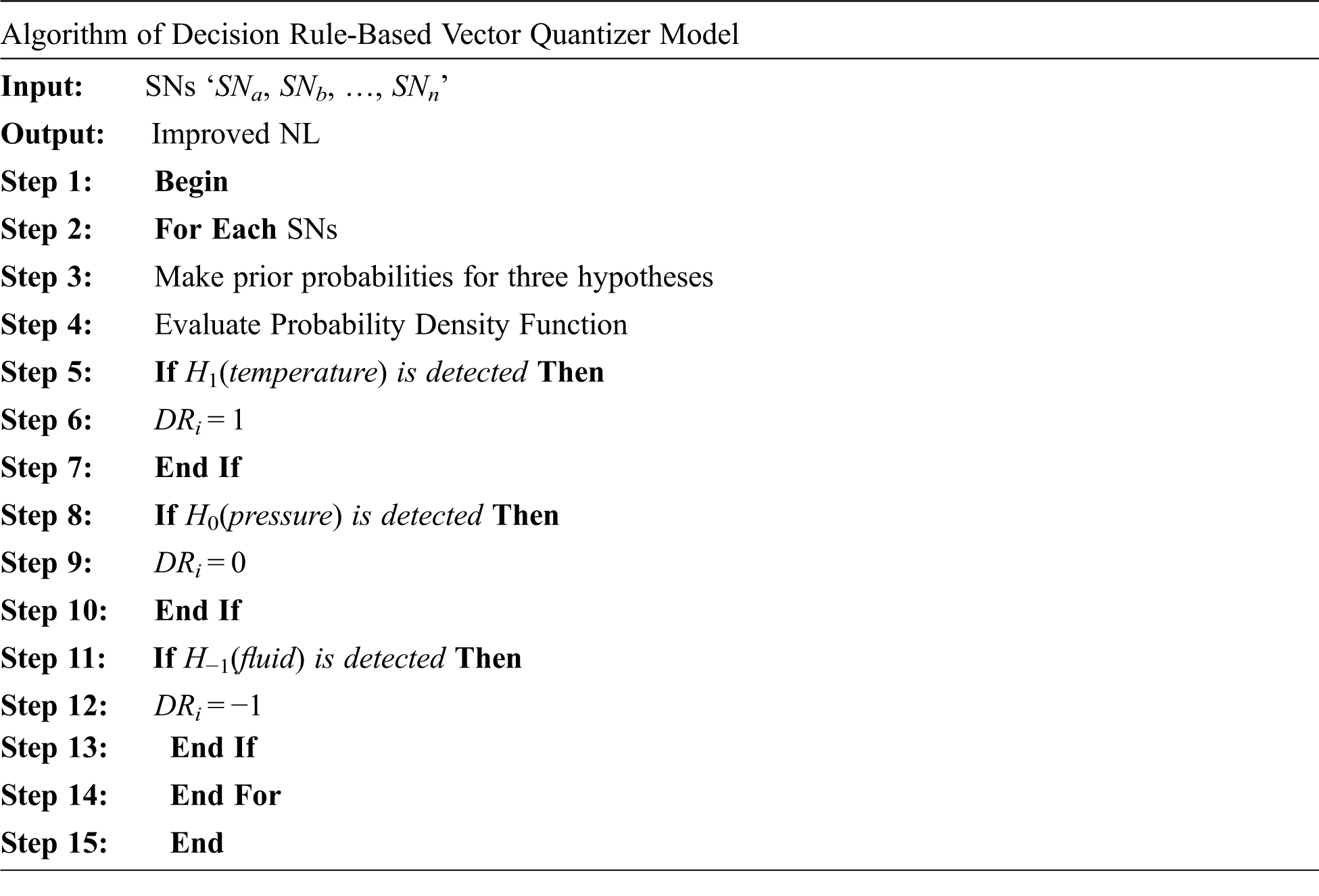
3.3 Secure and Energy Efficient Based Aggregation Data Routing in Wireless Sensor Network
Finally, SEE-INASD scheme is described. INA, WSN is a mechanism used to decrease the network cost of CO and increase the NL. INA minimizes the redundancy and nonessential data forwarding and also increases the NL. SEE-INASDR algorithm takes the sink node, Aggregator Node (AN), and application node for secure routing with efficient energy network formation. SEE-INASDR algorithm builds a DR for the multiple events in many application sensor environments. The events are examined from the application node and forwarded to the active AN. The AN is used to locate and choose the nearest sink node [16].
A secure and energy-efficient DA is obtained along with DR. The hop tree with IM. SEE-INASDR algorithm provides a Route Secure Mechanism (RSM), which consists of two parts: detection of failure node and a new node selection. This primary part can detect the nodes carrying data packets, which are sent to the sink node. It sends an acknowledgment on whether the sending nodes result in causing delay or failure. Due to this fact, the RSM creates the selection of the new node in the process to be continued. This mechanism also provides SDA [17,18].
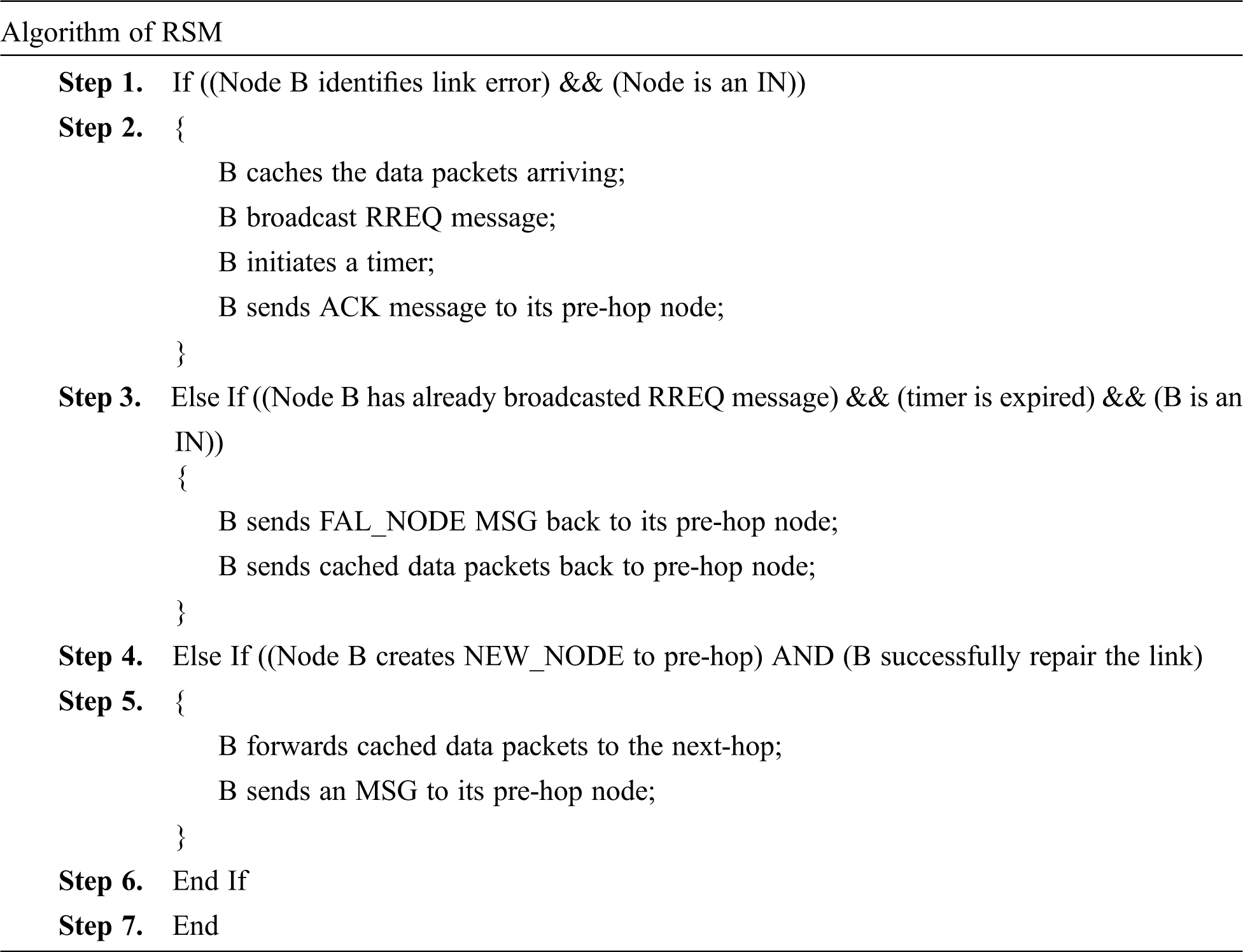
4.1 Analysis of BNEPD, MSDSS, SEE-INASDR Frameworks
Experiments are conducted for the proposed BNEPD, MSDSS, and SEE-INASDR techniques with the existing DRINA for WSNs. Simulations are carried out to measure in terms of EC, EDR, CO, NL, resource utilization, multi-sensed DAR, throughput, and CO to prove the real-time usage practically. Detailed result analyses of these metrics are elaborated in the following sections [19,20].
4.2 Measurement of Energy Consumption
EC is defined as the product of SNs, power (watts), and time (ms). Joules (J) is the measurement of the EC. The EC that requires mathematical formulation is given in Eq. (1):
The EC is measured based on number of SNs. Tab. 1 shows the comparison made with the proposed BNEPD Fig. 3, MSDSS, and SEE-INASDR framework and existing DRINA for WSNs [21–25].

Fig. 4 illustrates the EC of the proposed methods of BNEPD, MSDSS, SEE-INASDR, and the existing method of DRINA. The proposed SEERP overcomes the existing approach. This is because energy-efficient DA is obtained through the dynamic route construction. In addition, reliable routing is obtained from application nodes to sink nodes through ANs in the WSN. This, in turn, reduces the node energy by 71.5% compared to the existing DRINA. Moreover, the proposed BNEPD and MSDSS perform secure and reliable data transmission between the ANs to sink nodes effectively and minimize the EC by 13.39% and 38.8% compared to the existing DRINA.

Figure 4: Measure of EC
4.3 Measurement of Energy Drain Rate
The EDR is measured using previous and newly calculated values with a number of SNs. It is measured in terms of Joules (J). The product of the number of SNs, old energy, and new EDR as given in Eq. (2) is EDR.
The EDR measurements of three proposed methods, BNEPD, MSDSS, and SEE-INASDR, and the existing DRINA for WSNs, are shown in Tab. 2. The resultant values are plotted in a graph. Therefore, the proposed BNEPD framework uses the PRF to reduce the rate of energy drain.

The variation in the EDR of different SNs and the comparison of three proposed BNEPD, MSDSS, and SEE-INASDR methods with the existing DRINA are illustrated in Fig. 5. Through stable and powerful node positions ranging from 50 to 350 ms, simulations are conducted. It is abrupt from the figure that the training rate also escalates when the number of SNs escalates. However, the proposed BNEPD has minimum EDR. In addition, there is a maintenance of high energy nodes in the routing path by deploying PRF in the BNEPD technique with minimum EDR of 24.9% compared to DRINA. In addition, the proposed MSDSS framework reduces the EDR by 17.53% when compared to the existing DRINA. Similarly, the proposed SEE-INASDR framework minimizes the EDR by 8.9% than the state-of-art method.
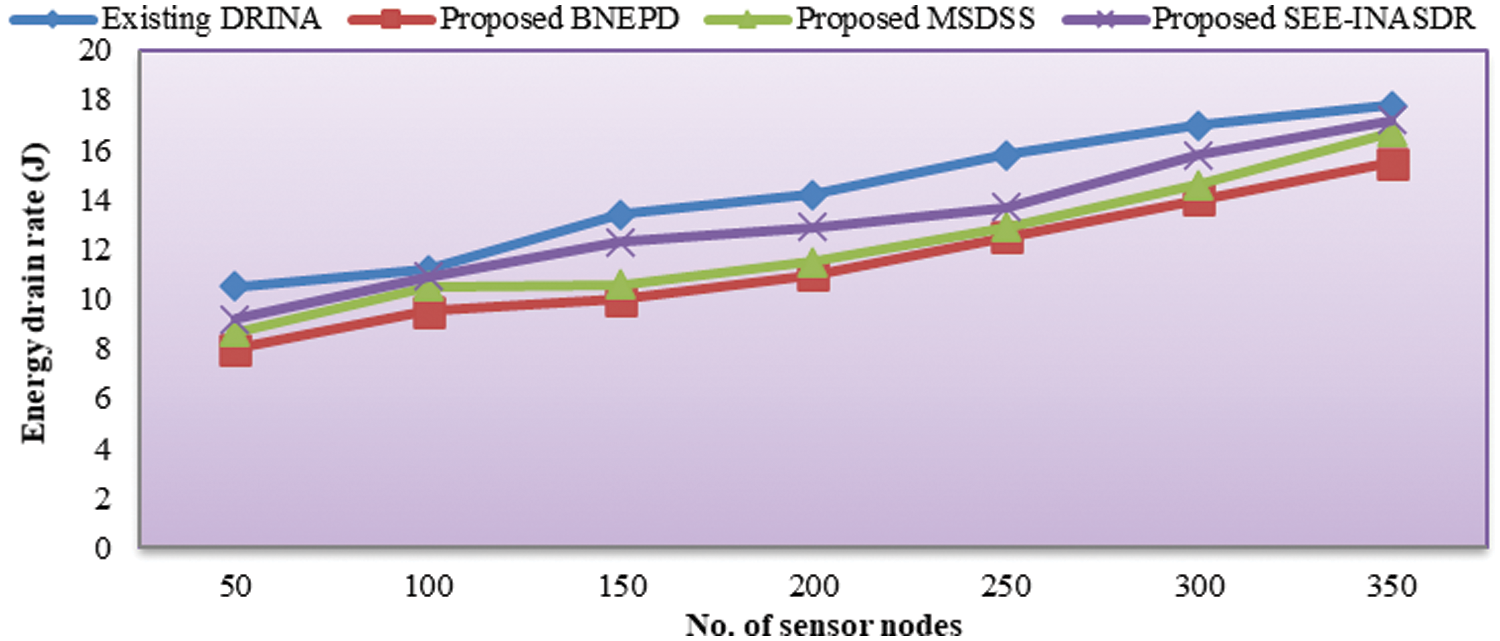
Figure 5: Measure of EDR
4.4 Measurement of Communication Overhead
The difference between actual communication time and measured to actual communication time as given in Eq. (3) is defined as CO. The unit of measurement is milliseconds (ms).
Tab. 3 reveals the CO of 350 SNs. The proposed BNEPD, MSDSS, and SEE-INASDR techniques are compared with existing DRINA. The CO also increased with the increase in the number of SNs. The proposed BNEPD technique minimizes the CO compared to the other proposed MSDSS and SEE-INASDR methods.

Fig. 6 shows that by using BNEPD, MSDSS, and SEE-INASDR techniques, the CO’s simulation results with the enhanced method viz., DRINA. The proposed technique called Bayes Node Energy Polynomial Distribution differs from existing DRINA and the other frameworks. The ceasing of sensing and sending data to the sink node for a particular time period is done by the incorporation of Poly Distribution, which reduces the CO. The mapping function is also performed by the BNEPD method, and by 23.3%, it again minimizes the CO compared to DRINA. Comparable performance is achieved by the BNEPD technique than the DRINA for WSNs for the predominantly distinct number of SNs. The COs of proposed MSDSS and SEE-INASDR technique are also reduced by 15% and 9% when compared with the state-of-art work method.
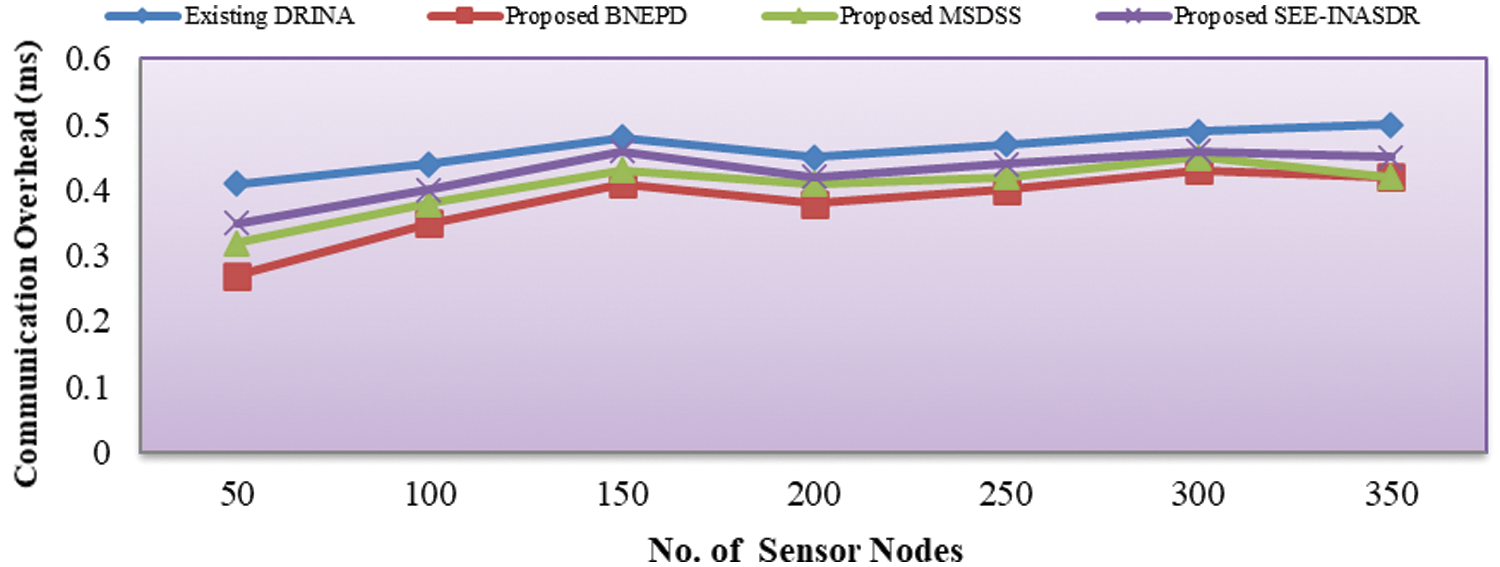
Figure 6: Measure of CO
4.5 Measurement of Network Lifetime
After the recurrent DA in WSN, the number of SNs in the network determines the network’s lifetime. Eq. (4) formulates the NL.
Using the total number of SNs, ‘TotalSN’ in the network and the SN addressed ‘SNaddressed’ for DA in WSN, are measured by the network lifetime ‘NL’. The measurement is done in terms of percentage (%).
The targeting results of NL using BNEPD, MSDSS, and SEE-INASDR framework with a state-of-the-art method, namely existing DRINA, are shown in Tab. 4. The comparison is obtained based on the number of SNs in WSN. The NL is increased in the proposed MSDSS framework.

Fig. 7 depicts the measurement of NL using three proposed BNEPD, MSDSS, and SEE-INASDR techniques with the existing DRINA. In the MSDSS framework, the Distributed detection of M-SE by vector quantizer with optimal strategy is used to improve the NL. The application of distributed detection of events and synchronization of data scheduling to resultant SN is performed in an efficient manner at different time intervals. This, in turn, improves the NL. At the same time, in MSDSS framework, the efficient mapping of detected events at different pulse times to multi-sensor event detection is performed. With the efficient mapping, the vector quantizer performs DA and sends the results of synthesized mapped events to the sink node in WSN. This, in turn, increases the NL using MSDSS framework by 21.64% compared to existing DRINA. In addition, the proposed BNEPD and SEE-INASDR techniques improved the NL by 5.44% and 14.12%, respectively.
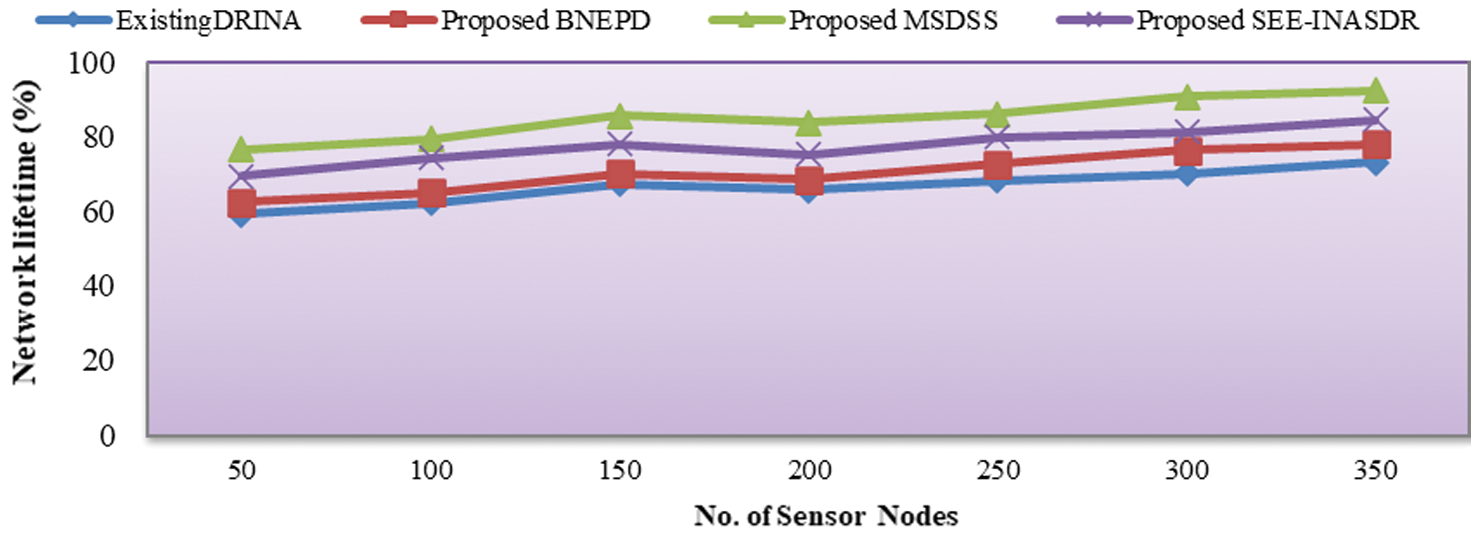
Figure 7: Measurement of NL
4.6 Measurement of Resource Utilization
Resource Utilization (RU) measures the amount of time taken to select the resource being utilized for multi-sensor event detection with respect to the number of SN. Resource utilization is formulated as, Eq. (5)
Resource utilization measured using the number of SN is ‘SNi’ and the time to assign the resource for multi-sensor event detection (i.e., Hypothesis) is ‘Hi’ respectively.
Experimental results of resource utilization with different numbers of SN values are displayed in Tab. 5. With the increasing number of SNs, measuring the resources utilized during DA at sink node increases though the increase is not linear. The reason is the movements of SN at different periods.

Fig. 8 shows the time taken to assign the resource utilized for multi-sensor event detection with respect to the number of SN in WSN adopted for the experiment. When compared to other two proposed methods and existing DRINA, there is a better performance of the proposed MSDSS framework. By applying a decision rule-based vector quantizer algorithm, the resource utilization overhead is reduced in the MSDSS framework. This algorithm is applied for efficient event detection using probability density function in WSNs. This helps in reducing the resource utilization by 41.7% compared to DRINA. The proposed BNEPD and SEE-INASDR framework also minimize the resource utilization by 23.35% and 13.7% compared to the existing DRINA for WSNs.

Figure 8: Measure of resource utilization
4.7 Measurement of Multi-Sensed Data Aggregation Rate
Multi-sensed DAR at the sink with respect to the number of SN and multiple events is detected in WSN that ranges between 10–70, with multiple events.
Tab. 6 illustrates the performance of DAR based on three proposed methods, namely BNEPD, MSDSS and SEE-INASDR, and existing DRINA. The multi sensed DAR of MSDSS framework increased the performance and overcame the existing approach.

Fig. 9 depicts the performance results of multi-sensed DAR using BNEPD, MSDSS, and SEE-INASDR methods and existing DRINA approach. The proposed MSDSS framework performs better compared to the existing state-of-art method and other proposed works. By applying synchronized thread, separation of M-SE is performed in an efficient manner, in turn increasing the multi-sensed DAR. This synchronized thread is also used for multi-sensor event detection in MSDSS framework, and the DAR at the sink is improved. Moreover, mapping the detected event with the corresponding sensor event results in the improved multi-sensed DAR by 15.54% compared to existing DRINA. Similarly, the proposed BNEPD and SEE-INASDR frameworks also increased the multi-sensed DAR by 7.1% and 11.12%, respectively.

Figure 9: Measurement of multi-sensed DAR
The successful data’s average rate delivered between application nodes to sink nodes within the specified time period is meant by NT. The more the NT, the more effective the method is, computed in terms of Mbps.
Tab. 7 describes the performance analysis of throughput based on three proposed works, namely BNEPD, MSDSS, and SEE-INASDR. These three works are compared with existing DRINA. The throughput of the proposed SEE-INASDR framework provides better results than the state-of-the-art method.

From Fig. 10, it is clear that three proposed works, viz., BNEPD, MSDSS, and SEE-INASDR, are compared with the existing DRINA. The proposed SEE-INASDR increases the throughput rate compared to the state-of-art methods. With the application of route mechanism algorithm in SEE-INASDR framework, the data transmission is increased by reducing the malicious node. In addition, secure DR protocol slightly increases the NT by 12.5% when compared with existing DRINA. Similarly, throughput measurement of BNEPD and MSDSS have also increased by 4.4% and 8.85% than the state-of-art method.

Figure 10: Measure of throughput
4.9 Measurement of Communication Overhead
CO is defined as the ratio of the total number of data forwarded by the transmitter to the number delivered to the receivers, Eq. (6).
The CO is measured on the number of data packets that are successfully received at the destination. The proposed methods, namely, BNEPD, MSDSS, and SEE-INASDR, are compared with existing DRINA. The performance results of the proposed and existing works are shown in Tab. 8. Fig. 11 depicts the targeting results of BNEPD, MSDSS, and SEE-INASDR frameworks with existing DRINA method. It is seen that the proposed SEE-INASDR method increases the CO. However, the number of data packets is successfully received using SEE-INASDR framework with minimal execution time. The CO is increased using SEE-INASDR framework by 37.9% compared to existing DRINA. And also, the CO has improved using BNEPD and MSDSS frameworks by 31.2% and 24.1% when compared to existing DRINA methods.
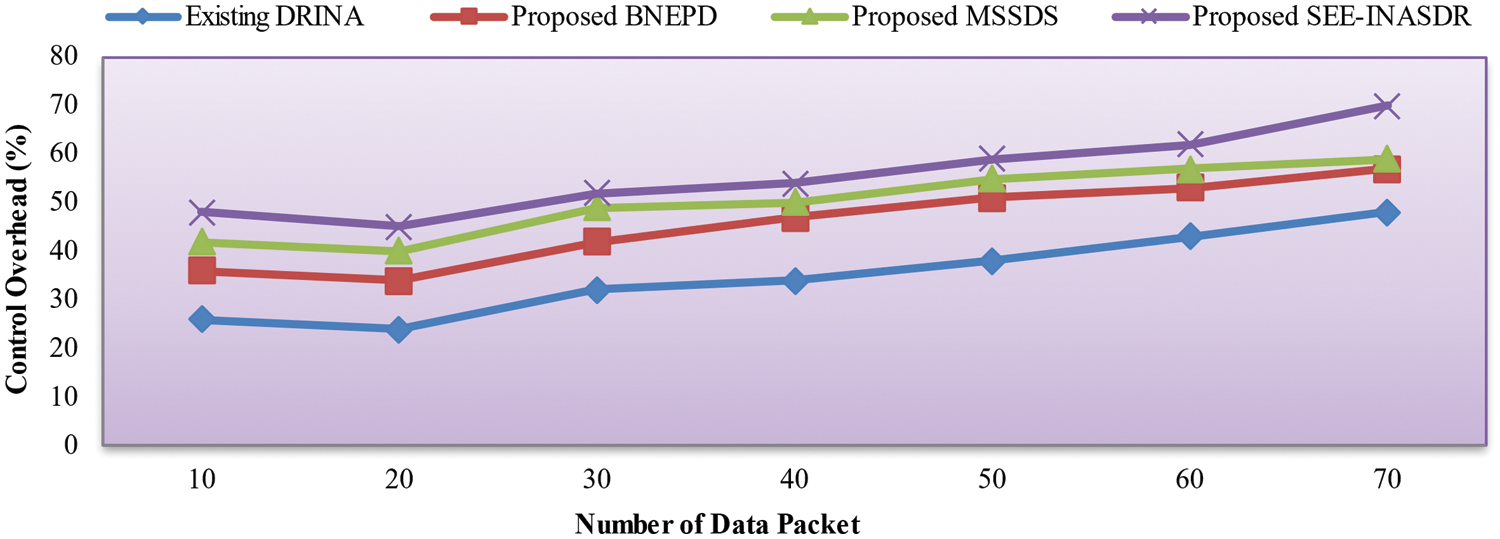
Figure 11: Measure of SEE-INASDR-CO

The Secure and Energy Efficient In-Network Aggregation Data Routing (SEE-INASDR) scheme with secure route mechanism is developed for secure and reliable data delivery in WSN. The high-performance routes are selected by using node vector function. This, in turn, reduces the EC. MSSDS is developed on the workflow-based data synchronization and distributed detection from multi-sensor with a vector quantizer for WSN. This MSSDS framework minimizes the EC during data synchronization at the sink node, improving the NL in WSN. Work flow-based algorithm performs data synchronization in an efficient manner, which minimizes the runtime and, therefore, improves the efficiency of the system and the overall network performance. Distributed detection from multi-sensor with a vector quantizer that is used in MSSDS framework conserves the energy during multiple detections of events and overcomes the difficulty of the resource utilization in WSN. Finally, synchronization thread is applied for efficient mapping of event detection with corresponding sensor events to the related thread that is performed in a significant manner. The NS-2 results demonstrate that the proposed SEE-INASDR framework provides better EC, throughput, NL, and CO performance. The EC of SEE-INASDR framework has significantly reduced by 51.2% using a SEERP protocol. The proposed MSDSS framework increased 15.4% of NL by applying workflow-based data synchronization.
In addition, by applying synchronization thread for M-SE detection in the MSDSS framework, the DAR at the sink has improved by 10.5%. Because of PRF in BNEPD technique, the EDR has been reduced by 39.2% with the help of the proposed BNEPD method. Compared to the advanced research, the CO has been significantly reduced by 33.5% by the poly distribution algorithm.
Funding Statement: This research work was funded by Institutional Fund Projects Under Grant No. (IFPIP-471-611-1442). Therefore, the authors gratefully acknowledge technical and financial support from the Ministry of Education and King Abdulaziz University, Jeddah, Saudi Arabia.
Conflicts of Interest: The authors declare that they have no conflicts of interest to report regarding the present study.
1. J. Liu, K. Xiong, P. Fan and Z. Zhong, “Resource allocation in wireless powered sensor networks with circuit energy consumption constraints,” IEEE Access, vol. 5, pp. 22775–22782, 2017. [Google Scholar]
2. D. Setiawan, A. A. Aziz, D. I. Kim and K. W. Choi, “Experiment, modeling, and analysis of wireless-powered sensor network for energy neutral power management,” IEEE Systems Journal, vol. 12, no. 4, pp. 3381–3392, 2018. [Google Scholar]
3. M. Wang, W. C. Yeh, T. C. Chu, X. Zhang et al., “Solving multi-objective fuzzy optimization in wireless smart sensor networks under uncertainty using a hybrid of IFR and SSO algorithm,” Energies, vol. 11, no. 9, pp. 2385, 2018. [Google Scholar]
4. Z. Zhang, W. Wu, J. Yuan and D. Z. Du, “Breach-free sleep-wakeup scheduling for barrier coverage with heterogeneous wireless sensors,” IEEE/ACM Transactions on Networking, vol. 26, no. 5, pp. 2404–2413, 2018. [Google Scholar]
5. R. Wan, N. Xiong and N. T. Loc, “An energy-efficient sleep scheduling mechanism with similarity measure for wireless sensor networks,” Human-Centric Computing and Information Sciences, vol. 8, no. 1, pp. 18, 2018. [Google Scholar]
6. K. Muhammad, S. Khan, M. Elhoseny, S. Hassan Ahmed and S. Wook Baik, “Efficient fire detection for uncertain surveillance environment,” IEEE Transactions on Industrial Informatics, vol. 15, no. 5, pp. 3113–3122, 2019. [Google Scholar]
7. M. Hammoudeh, F. Al-Fayez and H. Lloyd, “A wireless sensor network border monitoring system: Deployment issues and routing protocols,” IEEE Sensors Journal, vol. 17, no. 8, pp. 2572–2582, 2017. [Google Scholar]
8. A. Soderlund and M. Kumar, “Optimization of multitarget tracking within a sensor network via information-guided clustering,” Journal of Guidance, Control, and Dynamics, vol. 42, no. 2, pp. 317–334, 2019. [Google Scholar]
9. S. Shamshirband, J. H. Joloudari, M. Ghasemigol, H. Saadatfar, A. Mosavi et al., “FCS-MBFLEACH: Designing an energy-aware fault detection system for mobile wireless sensor networks,” Mathematics, vol. 8, no. 1, pp. 28, 2019. [Google Scholar]
10. K. Haseeb, N. Islam, A. Almogren, I. U. Din, H. N. Almajed et al., “Secret sharing-based energy-aware and multi-hop routing protocol for IoT based WSNs,” IEEE Access, vol. 7, pp. 79980–79988, 2019. [Google Scholar]
11. H. Gong, L. Fu, X. Fu, L. Zhao, K. Wang et al., “Distributed multicast tree construction in wireless sensor networks,” IEEE Transactions on Information Theory, vol. 63, no. 1, pp. 280–296, 2017. [Google Scholar]
12. P. Mathur, R. H. Nielsen, N. R. Prasad and R. Prasad, “Data collection using miniature aerial vehicles in wireless sensor networks,” IET Wireless Sensor Systems, vol. 6, no. 1, pp. 17–25, 2016. [Google Scholar]
13. M. Abo-Zahhad, S. M. Ahmed, N. Sabor and S. Sasaki, “Mobile sink-based adaptive immune energy-efficient clustering protocol for improving the lifetime and stability period of wireless sensor networks,” IEEE Sensors Journal, vol. 15, no. 8, pp. 4576–4586, 2015. [Google Scholar]
14. X. Liu, J. Yu, F. Li, W. Lv, Y. Wang et al., “Data aggregation in wireless sensor networks: From the perspective of security,” IEEE Internet of Things Journal, vol. 7, no. 7, pp. 6495–6513, 2020. [Google Scholar]
15. D. Liu, J. Shen, A. Wang and C. Wang, “Lightweight and practical node clustering authentication protocol for hierarchical wireless sensor networks,” International Journal of Sensor Networks, vol. 27, no. 2, pp. 95–102, 2018. [Google Scholar]
16. M. Song and M. Zheng, “Energy efficiency optimization for wireless powered sensor networks with nonorthogonal multiple access,” IEEE Sensors Letters, vol. 2, no. 1, pp. 1–4, 2018. [Google Scholar]
17. S. Chowdhury and C. Giri, “EETC: Energy efficient tree-clustering in delay constrained wireless sensor network,” Wireless Personal Communications, vol. 109, no. 1, pp. 189–210, 2019. [Google Scholar]
18. S. Halder and S. D. Bit, “Enhancement of wireless sensor network lifetime by deploying heterogeneous nodes,” Journal of Network and Computer Applications, vol. 38, pp. 106–124, 2014. [Google Scholar]
19. J. Cui, L. Shao, H. Zhong, Y. Hu and L. Liu, “Data aggregation with end-to-end confidentiality and integrity for large-scale wireless sensor networks,” Peer-to-Peer Networking and Applications, vol. 11, no. 5, pp. 1022–1037, 2018. [Google Scholar]
20. S. Roy, M. Conti, S. Setia and S. Jajodia, “Secure data aggregation in wireless sensor networks,” IEEE Transactions on Information Forensics and Security, vol. 7, no. 3, pp. 1040–1052, 2012. [Google Scholar]
21. P. Thirumoorthy and N. K. Karthikeyan, “Bayes node energy polynomial distribution to improve routing in wireless sensor network,” PLoS ONE, vol. 10, no. 10:e0138932, pp. 1–15, 2015. [Google Scholar]
22. P. Thirumoorthy, P. Kalyanasundaram, S. Karupusamy and S. Prabhu, “Energy efficient routing in WSNs using delay aware dynamic routing protocol,” Journal of Critical, vol. 6, no. 6, pp. 455–459, 2019. [Google Scholar]
23. P. Thirumoorthy, P. Kalyanasundaram, R. Maheswar and G. R. Kanagachidambaresan, “Time-critical energy minimization protocol using PQM (TCEM-PQM) for wireless body sensor network,” Journal of Supercomputing, vol. 76, no. 8, pp. 5862–5872, 2019. [Google Scholar]
24. S. Sudha, B. Manimegalai and P. Thirumoorthy, “A study on routing approach for in-network aggregation in wireless sensor networks,” in IEEE Int. Conf. on Computer Communication and Informatics, Coimbatore, India, pp. 1–4, 2014. [Google Scholar]
25. K. Ganesh Kumar and S. Sudhakar, “Improved network traffic by attacking denial of service to protect resource using z-test based 4-tier geomark traceback (Z4TGT),” Wireless Personal Communications, vol. 114, no. 4, pp. 3541–3575, 2020. [Google Scholar]
 | This work is licensed under a Creative Commons Attribution 4.0 International License, which permits unrestricted use, distribution, and reproduction in any medium, provided the original work is properly cited. |